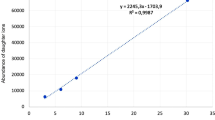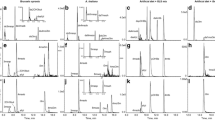Abstract
Arachidonic acid, cellulase, CuSO4, a sonicate of Phytophthora infestans mycelium and a spore suspension of Penicillium chrysogenum all elicited the formation of the sesquiterpenoid phytoalexins lubimin, 3-hydroxylubimin and rishitin in fruit cavities of Datura stramonium. 3-Hydroxylubimin was the predominant phytoalexin formed after treatment of the fruits with arachidonic acid, cellulase and the P. infestans preparation. Copper sulphate was a potent elicitor of lubimin but not 3-hydroxylubimin. The fungus P. chrysogenum metabolized lubimin and 3-hydroxylubimin to 15-dihydrolubimin and 3-hydroxy-15-dihydrolubimin respectively, both in fruit cavities inoculated with spores of this fungus and in pure culture. The 15-dihydrolubimin formed in the fruits by the fungus was further metabolized (by the fruits) to both isolubimin and 3-hydroxy-15-dihydrolubimin. The precursor-product relationships between all of the subject compounds was investigated by feeding experiments with 3H-labelled compounds. 2-Dehydro-[15-3H1]lubimin was rapidly and efficiently incorporated into lubimin and may be the direct precursor of lubimin in planta. 3-Hydroxy[2-3H1]lubimin was incorporated into the nor-eudesmane rishitin but 10-epi-3-hydroxy[2-3H1]lubimin was not. An updated scheme for the biosynthesis and metabolism of lubimin and related compounds in infected tissues of solanaceous plants is presented.
Similar content being viewed by others
References
Rostock, R.M., Kuć, J.A. (1981) Eicosapentaenoic and arachidonic acids from Phytophthora infestans elicit fungitoxic sesquiterpenoids in the potato. Science 212, 67
Coolbear, T., Threlfall, D.R. (1985) The biosynthesis of lubimin from [1-14C]isoopentenyl pyrophosphate by cell-free extracts of potato tuber tissue inoculated with an elicitor preparation from Phytophthora infestans. Phytochemistry 24, 1963–1971
Desjardins, A.E., Gardner, H.W., Plattner, R.D. (1989) Detoxification of the potato phytoalexin lubimin by Gibberella pulicaris. Phytochemistry 28, 431–437
Ewing, D.F., Whitehead, I.M., Atkinson, A.L., Threlfall, D.R. (1990) 1H NMR Study of the stereochemistry of lubimin and related vetispirane sesquiterpenoids. J. Chem. Soc. Perkin Trans. 2, 343–348
Kalan, E.B., Osman, S.F. (1976) Isolubimin: a possible precursor of lubimin in infected potato slices. Phytochemistry 15, 775–776
Kalan, E.B., Patterson, J.M., Schwarz, D.P. (1976) Metabolism of isolubimin and hydroxylmethyllubimin by potato tuber slices. (Abstr.) Plant Physiol. 57, Suppl., 91
Katsui, N., Matsunaga, A., Kitakara, H., Yagihashi, F., Murai, A., Masamune, T., Sato, N. (1977) Lubimin and oxylubimin. The structure elucidation. Bull. Chem. Soc. Jpn. 50, 1217–1225
Katsui, N., Yagihasi, F., Murai, A., Masamune, T. (1978) Structure of oxyglutinosone and epioxylubimin, stress metabolites from diseased potato tubers. Chem. Lett. 1205–1206
Murai, A. (1987) Phytoalexin chemistry and action. In: Pesticide science and biotechnology (Proc. Int. Congr. Pestic. Chem.), p. 81, Greenhalgh, R., Roberts, T.T., eds. Blackwell, Oxford, UK
Sato, K., Ishiguri, Y., Doke, N., Tomiyama, K., Yagishashi, F., Murai, A., Katsui, N., Masamune, T. (1978) Biosynthesis of the sesquiterpenoid phytoalexin rishitin from acetate via oxylubimin in potato. Phytochemistry 17, 1901–1902
Stoessl, A., Stothers, J.B. (1980) 2-Epi and 15-dihydro-2-epi-lubimin: new stress compounds from the potato. Can. J. Chem. 58, 2069–2072
Stoessl, A., Stothers, J.B. (1981) A carbon-13 biosynthetic study of stress metabolites from potatoes: the origin of isolubimin. Can. J. Bot. 59, 637–639
Stoessl, A., Stothers, J.B., Ward, E.W.B. (1978) Biosynthetic studies of stress metabolites from potatoes: incorporation of sodium acetate-13C2 into 10 sesquiterpenes. Can. J. Chem. 56, 645–653
Threlfall, D.R., Whitehead, I.M. (1988a) Co-ordinated inhibition of squalene synthetase and induction of enzymes of sesquiterpenoid phytoalexin biosynthesis in cultures of Nicotiana tabacum. Phytochemistry 27, 2567–2580
Threlfall, D.R., Whitehead, I.M. (1988b) The use of biotic and abiotic elicitors to induce the formation of secondary plant products in cell suspension cultures of solanaceous plants. Biochem. Soc. Trans. 16, 71–75
Threlfall, D.R., Whitehead, I.M. (1988c) The use of metals ions to induce the formation of secondary products in plant tissue culture. In: Manipulating secondary metabolism in culture, p. 51–56, R.J. Robins, M.J.C. Rhodes, eds. Cambridge University Press
Tomioka, H., Takai, K., Oshima, K., Nozaki, H. (1981) Selective oxidation of a primary hydroxyl in the presence of a secondary one. Tetrahedron Lett. 22, 1605–1608
Waldi, D. (1965) Spray reagents for thin-layer chromatography. In: Thin Layer Chromatography, p. 485, Stahl, E., ed. Springer, Berlin Heidelberg New York
Ward, E.W.B., Stoessl, A. (1973) Postinfectional inhibitors from plants. III. Detoxification of capsidiol, an antifungal compound from peppers. Phytopathology 62, 1186–1187
Ward, E.W.B., Stoessl, A. (1976) Phytoalexins from potatoes: evidence for the conversion of lubimin to 15-dihydrolubimin by fungi. Phytopathology 67, 468–471
Ward, E.W.B., Unwin, C.H., Hill, J., Stoessl, A. (1976a) Sesquiterpenoid phytoalexins from fruits of eggplants. Phytopathology 65, 859–863
Ward, E.W.B., Unwin, C.H., Rock, G.L., Stoessl, A. (1976b) Post-infectional inhibitors from plants. XXIII. Sesquiterpenoid phytoalexins from fruits capsules of Datura stramonium. Can. J. Bot. 54, 25–29
Watson, D.G., Brooks, C.J.W. (1984) Formation of capsidiol in Capsicum annuum fruits in response to non-specific elicitors. Physiol. Plant Pathol. 24, 331–337
Whitehead, I.M., Threlfall, D.R., Ewing, D.F. (1987) Cis-9, 10-dihydrocapsenone: a possible catabolite of capsidiol from cell suspension cultures of Capsicum annuum. Phytochemistry 26, 1367–1369
Whitehead, I.M., Ewing, D.F., Threlfall, D.R. (1988) Sesquiterpenoids related to the phytoalexin debneyol from elicited cell suspension cultures of Nicotiana tabacum. Phytochemistry 27, 1365–1370
Whitehead, I.M., Threlfall, D.R., Ewing, D.F. (1989a) 5-Epi-aristolochene is a common precursor of the sequiterpenoid phytoalexins capsidiol and debneyol. Phytochemistry 28, 775–779
Whitehead, I.M., Ewing, D.F., Threlfall, D.R., Cane, D.E., Prabhakaran, P.C. (1989b) Synthesis of (+)-5-epi-aristolochene and (+)-1-deoxycapsidiol from capsidiol. Phytochemistry 29, 479–482
Author information
Authors and Affiliations
Additional information
We thank Mr Vic Swetez for the provision of plant material, Mrs Margaret Huffee for technical assistance, Dr David Ewing for help with obtaining NMR spectra, and the Agricultural and Food Research Council for financial support.
Rights and permissions
About this article
Cite this article
Whitehead, I.M., Atkinson, A.L. & Threlfall, D.R. Studies on the biosynthesis and metabolism of the phytoalexin lubimin and related compounds in Datura stramonium L.. Planta 182, 81–88 (1990). https://doi.org/10.1007/BF00239988
Accepted:
Issue Date:
DOI: https://doi.org/10.1007/BF00239988




